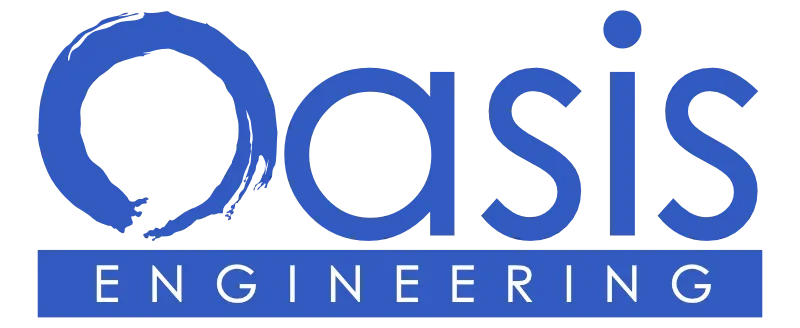Ensuring Safety and Compliance for Railings and Guardrails
When it comes to designing elevated decks, porches, and outdoor spaces, safety is paramount. One critical component in safeguarding these structures is the installation of guardrails (also known as guards or railings). At Oasis Engineering, we understand the complexities of guardrail engineering and are committed to providing top-notch solutions that meet and exceed industry standards.

Understanding Guardrails vs. Handrails
It’s common to confuse guardrails with handrails, but international building codes clearly distinguish between the two:
- Handrails are designed to provide support along ramps and stairs, offering stability for individuals navigating these areas.
- Guardrails, on the other hand, are life-saving barriers intended to prevent falls from elevated surfaces such as decks, porches, and balconies.
While both are essential for safety, guardrails serve the crucial function of arresting falls, ensuring the safety of occupants by acting as a physical barrier against accidental drops.
The Importance of Guardrails in Elevated Structures
Elevated decks and porches present unique safety challenges. Guardrails are not just regulatory requirements—they are vital for protecting lives. Properly engineered guardrails can:
- Prevent Accidental Falls: By providing a secure barrier, guardrails stop individuals from accidentally stepping off elevated surfaces.
- Enhance Structural Integrity: High-quality guardrails contribute to the overall stability and durability of your deck or porch.
- Increase Property Value: Safety features like robust guardrails make your property more attractive and valuable.
International Building Code (IBC) Standards for Guardrails
At Oasis, we prioritize compliance with the International Building Code (IBC), the standard code for construction, or local building codes as required. The IBC outlines comprehensive requirements to ensure public health, safety, and welfare. Here are the key IBC standards we adhere to for guardrail installations:
- Guardrail Location Requirements (IBC Section 1015.2):
- Guardrails must be installed along open-sided walking surfaces, including stairs, ramps, aisles, and landings exceeding 30 inches in height.
- Exceptions include areas near loading docks, stages, vehicle service pits, and specific maintenance access points.
- Minimum Height of 42 Inches (IBC Section 1015.3):
- Guardrails must not be less than 42 inches in height, measured vertically from any adjacent walking surface.
- For areas with a drop of 30 inches or more, a handrail may need to accompany the guardrail, positioned between 34 and 38 inches above the nosing.
- Opening Limitations:
- 4-Inch Sphere Rule: Openings in guardrails must prevent a sphere with a 4-inch diameter from passing through.
- Exceptions: Specific scenarios, such as glass balusters and cable railing systems, have tailored requirements to maintain safety without compromising design aesthetics.
- Guardrail Load Requirements (IBC Section 1607.8.1):
- Guardrails must withstand a linear load of 50 pounds per linear foot.
- Additionally, they must support a concentrated load of 200 pounds, ensuring resilience against substantial force.
Beyond IBC: OSHA Standards for Enhanced Safety
In industrial environments, OSHA (Occupational Safety and Health Administration) standards also apply:
- Load Resistance: Guardrails must resist at least 200 pounds of pressure applied directly to the structure, ensuring they remain intact under significant stress.
- Maintenance and Inspection: Regular inspections and maintenance are crucial to uphold the integrity and functionality of guardrails in high-traffic or industrial settings.
Expertise in Guardrail Engineering
At Oasis Engineering, we specialize in designing, engineering, and installing guardrails that not only comply with IBC and OSHA standards but also enhance the aesthetic appeal of your project. Our services include:
- Elevated Decks and Porches: Customized guardrail solutions that blend safety with style, tailored to your specific design preferences and structural requirements.
- Metal Fabricators’ Shop Drawings: Precise and detailed shop drawings that facilitate seamless integration of guardrails into metal fabrication projects, ensuring accuracy and compliance.
- Commercial Projects: Comprehensive guardrail engineering for commercial buildings, ensuring that all safety codes are met and exceeded for public and employee safety.
Why Choose Oasis for Your Guardrail Needs?
- Expertise and Experience: With years of experience in structural engineering, our team possesses the knowledge and skills to handle complex guardrail projects.
- Compliance Assurance: We stay up-to-date with the latest IBC and OSHA codes, ensuring that every guardrail we install meets the highest safety standards.
- Custom Solutions: We understand that every project is unique. Our customized guardrail designs cater to your specific requirements, balancing functionality with aesthetic appeal.
- Quality Materials: We use only the highest quality materials to ensure durability, strength, and longevity of our guardrail systems.
Contact Oasis for Your Next Project
Safety and compliance are non-negotiable when it comes to elevated structures. Let Oasis provide you with guardrail solutions that offer peace of mind and enhance the safety of your space. Whether you’re designing a new deck, upgrading an existing porch, or working on a commercial project, our team is here to support you every step of the way.
Get in touch with Oasis today to discuss your guardrail engineering needs and ensure your project meets all safety and code requirements!

